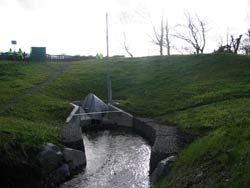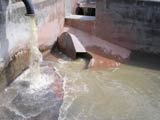
Versatile Vortex Valves
They're not just for stormwater anymore
- By Robert Y.G. Andoh, Neil G. Raymond
- Dec 16, 2008
 Water industry officials often consider vortex valves a novel technology for outlet flow control within stormwater detention systems. That's why the majority of the 17,000+ vortex valve installations in Europe and North America are used in stormwater detention. These units, however, can be implemented in water management systems to reduce erosion, aerate discharge, and equalize flow, among other things.
Water industry officials often consider vortex valves a novel technology for outlet flow control within stormwater detention systems. That's why the majority of the 17,000+ vortex valve installations in Europe and North America are used in stormwater detention. These units, however, can be implemented in water management systems to reduce erosion, aerate discharge, and equalize flow, among other things.
Vortex valves are ideal for preventing erosion where outlet pipes release water to a channel bed. During low-flow conditions, the valve acts as a large orifice and slowly conveys water from a pipe into a receiving channel. As flow increases, water spins in a vortex pattern, forming an air core. As the head continues to increase, the air core stabilizes, throttling back the valve discharge to a flow rate equal that of a significantly smaller orifice. The air core enables the discharge to exit in a fan-shape, which creates much less erosive velocity than a jet stream. This fan-shaped spray also helps to prevent the formation of sinkholes near drainage pipe outlets.
Another advantage of the device is that it aerates water. Surface pond and underground chambers used for stormwater retention tend to deplete dissolved oxygen levels. Merely discharging water stored underground into a river or stream without first improving the oxygen quality can be detrimental to nearby animal and plant life. As flow is released from systems using vortex valves, the resulting water spray reintroduces oxygen and improves water quality.
 Sewer Overflows
Sewer Overflows
More and more vortex valves are being used to alleviate overflow problems in combined sewer and sanitary sewer conveyance systems. Many older communities in Canada and the United States struggle with outmoded systems that carry sewage and stormwater in the same pipes. During heavy rains, the total combined flow may exceed the capacity of the treatment plant or conveyance pipes and cause the system to send untreated sewage into nearby rivers and streams.
To allay fears about water degradation and health effects after a period of overflow or discharge, the U.S. Environmental Protection Agency mandated that all communities having combined sewer overflows (CSOs) either eliminate or minimize them. The conventional approach for resolving this problem has been to either separate the sewers or expand the capacity of wastewater treatment plants. These methods are extremely costly and most communities cannot afford them.
In response, some CSO communities, such as Ottawa, Canada, are using vortex valves as inlet controls to regulate the flow of stormwater runoff that enters the combined sewer system during intense storms -- in essence preventing excess wet-weather flows from entering the combined sewer network and thereby preventing an overflow further downstream. Other cities, such as Richmond, Va., are using vortex valves to optimize in-line storage while reducing flows to the wastewater treatment facility.
A recent report released by the City of Ottawa revealed that 730,000 cubic meters of combined sewage overflowed from 18 overflow points in the nine-month rainy period of 2007. The city is currently working on a $25-million (CAN) plan that will eliminate most of the overflows. Phases I and II of the plan, to be implemented over the next two years, incorporate approximately 1,000 vortex valve units in catch basins around the city.
The City of Richmond, Va., has embarked on a $117-million CSO control program to protect the James River from receiving untreated sewage during storm events. The Program Project Plan, which shows the master plan for the Phase III CSO controls, was completed in 2006. Richmond uses vortex valves to regulate flows into the intercepting sewer. The swirling vortex action holds back the flows during a large storm and then sends floatable pollutants through the valve’s larger orifice after the storm. The regulated flows and larger opening keeps the valve from getting clogged during a large storm.
In a sewer overflow application, the vortex valve air core once again prevents excess amounts of water from entering the conveyance system. As flow increases and reaches the flush flow point, high peripheral velocities start to throttle the flow. As pressure increases, the air core, accompanied by substantial back pressure, effectively restricts the flow through the outlet aperture. Attenuated flow can be temporarily stored within the collection system or in underground tanks and/or tunnels, surface ponds, or on the street for slow release into the sewer system, thereby preventing overflow of combined sewage. Although costs vary by project, a good example of the savings vortex valves generate can be found in Evanston, Ill. Rather than separate its sewers, the city deployed a series of inlet control valves and rehabilitated some of its sewers, dropping the cost of the project by about a third, according to David Stoneback, superintendent of the Evanston Water & Sewer Division.
 Peak Flows
Peak Flows
Vortex valves also are used to protect wastewater treatment plants from the detrimental effects of peak wet-weather flows. Wastewater treatment plants must contend with surges in flow during peak usage times, such as early morning hours when many residents are taking showers. Combine these peak usage times with large amounts of rain and the plant will see a huge surge of flow that overwhelms treatment processes, causing the washout of pollutants from treatment processes, such as loss of solids from clarifier tanks and washout of activated sludge from aeration basins, or even the bypass of critical treatment systems.
With flow equalization, excess combined sewage is diverted to temporary storage and the maximum allowable flow is sent directly to the treatment plant. Once the storm subsides, the excess flow is directed back to the treatment plant. Vortex valves are now being used to control the flow through each stage of the treatment system, thereby preventing hydraulic overloading. The valves, for example, prevent flows from being transferred forward from the primary treatment stage to the secondary treatment stage before receiving adequate levels of treatment.
These devices also can be used to combat flow surges from saturated groundwater, high water tables, or illegal hookups to the drainage system. Because municipalities often have no way of knowing where illegal hookups are connected, they cannot predict when unexpected flow surges will occur and overload the system. Properly placed, vortex valves control this flow to prevent unexpected surges from taxing the system.
Stormwater Runoff Issues
Vortex valves can be fitted into inlet control systems to prevent trash from entering a drainage system. Some municipalities install hooded outlet covers to convert catch basins into low-cost stormwater best management practices that capture floatable trash. The device acts like a baffle, keeping floatable trash in the catch basin instead of allowing it to clog pipes. A vortex valve, with its ability to aerate flows, offers an alternative to hoods.
While retention ponds are the most common stormwater treatment and detection systems, urban settings are forcing developers to build underground storage vaults to capture stormwater runoff. Such was the conundrum facing Chevy Chase Bank when it began planning a new branch in Darnesville, Md. Initially, the site engineer recommended the use of an 826-cubic-meter storage tank to keep the depth of water in the tank shallow enough so that the head pressure didn’t drive too much water out of the 2-inch-diameter orifice, the minimum allowable outlet size in most American stormwater storage applications.
In the end, the firm used a 3-inch vortex valve with 350 percent more open surface area than the 2-inch orifice. The valve passes more flow at low head and throttles the flow back under higher head conditions. Thus, the engineers could increase the depth of the stormwater storage tank without causing the system to over-discharge. By reducing the volume of the tank and associated construction labor costs, the engineers saved more than $150,000 on the project.
Municipalities will continue to benefit from vortex valves as they discover the wide variety of innovative vortex valve applications that have alleviated many of the more troubling flooding and pollution challenges in communities worldwide.
About the Authors
Robert Y.G. Andoh is director of innovation for Hydro International of Portland, Maine, overseeing product research and development, technical support, intellectual property rights and IT.
Neil G. Raymond is General Manager of Hydro International’s US Wet Weather business, which provides products designed to improve management of wet weather flows within collection systems and wastewater treatment plants.